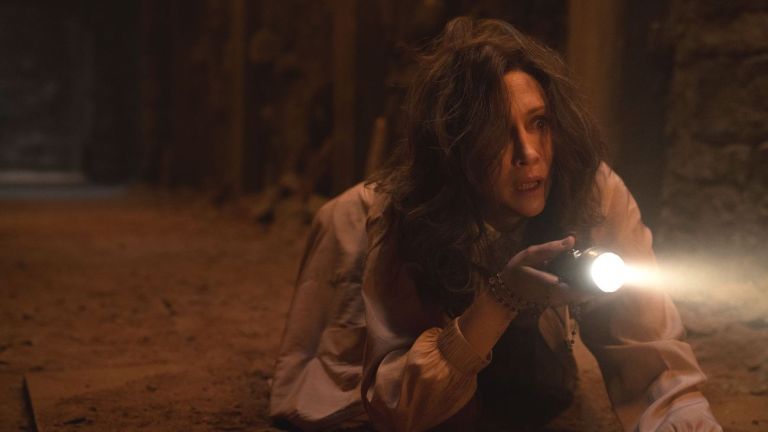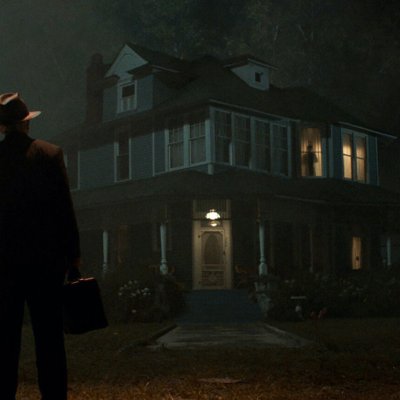The Conjuring: The Devil Made Me Do It Ending Explained
Devils, witches, and even lawyers all factor into the ending of The Conjuring: The Devil Made Me Do It!

This article contains The Conjuring: The Devil Made Me Do It spoilers. Read our spoiler-free review here.
The sun is shining brightly as Arne Cheyenne Johnson (Ruairi O’Connor) stands up before the courtroom. On this bright, seemingly glorious day in God’s country, the young man who once sacrificed his own body to a demon in order to save a child is about to receive his verdict from the jury. And, even before the film’s ending crawl explains what that sentence will be, he appears aware enough to know he’s about to go to prison. Yet the musical score of The Conjuring: The Devil Made Me Do It swells with optimistic acceptance, and the scene is is unmistakably upbeat. How can this be a happy ending?
Because what can be so bad on a day like this after the long night everyone just endured? Seriously, think about it: Of all the main line Conjuring films, The Devil Made Me Do It had the most per capita possessions, exorcisms, and even damnations of any we’ve seen. And in so doing, it marks the first of these horror movies where a five-year prison sentence is treated as uplifting…
Indeed, the two previous Conjuring movies, directed by James Wan, played out in somewhat more conventional fashions. After a cold open focused on Ed and Lorraine Warren (Patrick Wilson and Vera Farmiga) closing their previous case, we meet a new family of characters and spend up to an hour understanding their dynamics, and then their dawning awareness of demonic activity. For a surprisingly large chunk of The Conjuring 2, the Warrens are even off-screen before riding in to the rescue—always with a sense of healthy dose of rational skepticism about the evil forces at play.
The Conjuring: The Devil Made Me Do It jettisons that formula and begins where previous Warren movies ended: a full-blown megawatt exorcism set piece. The one at the top here particularly plays out like a cover band doing someone else’s greatest hits set list, in this case William Friedkin’s still masterful The Exorcist (1973). There’s a priest arriving on a foggy night; body contortions; decaying young faces screaming Latin; and a (near) fatal heart attack. But this is the opening salvo into a story, which is less of a “get the demons out” yarn than it is a whodunit murder mystery.
The who in question turns out to be a character we barely ever get to know: Father Kastner’s secret and occultist daughter. Raised in the same house where the Catholic Church and Kastner stored everything occult and unholy for study and hiding, the Kastner child (she’s never given a name in the movie) grew into a woman obsessed by her priestly father’s own unhealthy fixations.
The Warrens are also no strangers to keeping cursed and possessed objects in their own homes in the Conjuring movies. Warner Bros. even made a whole “haunted Night at the Museum” movie about it via Annabelle Comes Home. But it appears whatever dark secrets John Noble’s eccentric Father Kastner learned from the Disciples of the Ram, they were too evil and perverse for even Lorraine Warren. As soon as she feels just a trace of the evil stored in Kastner’s basement, she tells him he should have burned all the books he collected more than a decade ago.
What isn’t clear, however, is whether the Disciples of the Ram’s studies are what corrupted the mind of Kastner’s daughter, who in the film is a woman in her 50s played by Eugenie Bondurant. This means she grew up as a hidden bastard child in Kastner’s home during the 1930s and ‘40s. Meanwhile we’re told Kastner exposed the Disciples of the Ram about 10 to 12 years ago, which would’ve been in the late 1960s. In fact, members of that cult have appeared in The Conjuring universe, showing up in the first Annabelle spinoff for a home invasion sequence that’s clearly (some might say grossly) modeled after the murders perpetrated by the “Manson Family” in 1969.
In any event, Kastner’s daughter grew up sharing in her father’s perverse fascination with all things occult, but she took it further by indulging in the acts of evil and Satanism that he wished to expose as dangerous. Presumably she at least studied at some point the texts her father collected from the Disciples of the Ram, as she imitated their “blood sacrifices,” which involved cursing a family or person with a hidden totem in their home. This leads to temporary demonic possession, and subsequent murder and suicide. First the possessed individual kills someone, and then themselves, presumably damning their soul to Hell (it’s later said the unnamed demon in the movie cannot return to Hell without claiming soul, which Kastner’s daughter clearly intends to be Arne’s eternal fate).
Luckily, Wilson and Farmiga’s entirely selfless and loving versions of Ed and Lorraine Warren are on the case to unravel this—even at the risk of their own lives and souls after the witch sends a cursed totem to Ed’s study hidden inside a vase of flowers. He, too, is now being possessed and compelled to murder a loved one. When Lorraine Warren spies on the occultist’s subterranean lair by touching the corpse of poor Jessica (who presumably is burning in Hell according to the movie’s logic), Lorraine can hear a train in the distance.
When Ed and Drew (Shannon Kook) then later use a map of railways to figure out where a train might be passing at midnight, they deduce it is at the Kastner house. So we end up with a grand showdown where Ed and Lorraine face off against the Kastner daughter, who is now even going so far as to murder her own father, a feeble failure of a priest who apparently wasn’t even aware she was on his property for at least several months now.
Afterward Ed is possessed by the demon and goes the full Jack Torrence by picking up a sledgehammer and planning to murder his wife. But through the power of love, Lorraine gets through to Ed’s possessed heart, freeing him from demonic influence and allowing Ed to smash the witch’s altar, which for some unexplained reason also frees Arne—who’s about to kill himself back in prison—from the demon.
With the summoned demon no longer forced to do the bidding of the Kastner daughter, it decides to take her soul back to Hell with it. Arne is spared further demonic possession, and suddenly five years in prison doesn’t look so bad when compared to an eternity in Hell.
Frankly, the ending, like much else with The Conjuring 3, left this writer more than a bit underwhelmed. The idea of the villain being a daughter borne out of the dangerous study of the occult could’ve created a spooky narrative that hit closer to home for the Warrens. After all, they never burn their own creepy mementos, which have bedeviled their daughter Judy on more than one occasion onscreen, as seen in both the original The Conjuring and Annabelle Comes Home. A movie about the pair seeing a danger to their daughter reflected by the Kastners, and one that which perhaps incorporated the whole Warren family solving the case, might’ve made for a more emotionally satisfying movie. As with the first movie, we’d once again have a story of two families, with the Warrens seeing a more shadowy contrast in the Kastners.
It would’ve been more interesting than the plot in its current form, which appears a bit like a lazy riff on the demon-worshipping cult in Hereditary, arguably the most popular supernatural horror movie to be released since The Conjuring 2. The Conjuring 3, meanwhile, also was done no favors by its rushed narrative turning Arne and the Glatzel family into largely ciphers, depriving the audience of much cathartic investment until Ed starts getting possessed himself.
Granted, the real-life Judy Warren had nothing to do with this case and there never was a Father Kastner, so turning that into the focus of the movie would be stepping even further away from the main franchise’s increasingly dubious “based on a true story” shtick. But we’re so far from true stories, why quibble about that now? The Annabelle doll was never associated with Satanic cults or the Manson family, it never Night at the Museum’d Judy, and Ed did not have a heart attack during the Glatzel exorcism. In fact, Arne was not sentenced to five years.
Arne Cheyenne Johnson was convicted of first degree manslaughter and was sentenced to 10 to 20 years in prison—he only served five years. Additionally, the judge threw out his lawyer’s not-guilty plea by reason of demonic possession. The Conjuring 3 also did not show how Arne’s lawyer used the (legally dubious) evidence gathered by the Warrens at the Kastner house in court to get the prosecution’s charge down from first degree murder to manslaughter (the state was trying to send Johnson to the gas chamber in the film).
… But you know what? A Conjuring film that was an actual courtroom drama—perhaps with levitating witnesses and possessed prosecutors—would’ve also probably been more interesting than the movie we ended up with.


